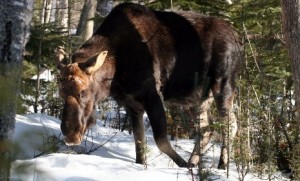Assistant Professor John Vucetich and Co-PI Rolf Peterson have received $36,600 from the US Department of Interior, National Park Service, for the first year of a five-year project, “Wolf-Moose Long-Term Monitoring on Isle Royale National Park 2011-2016.”
PlanetGreen.com featured an essay published by Assistant Professor John Vucetich and his colleague at Michigan State, Michael Nelson, as one of its five tips for actio n on Earth Day. See tip four at Tips .
n on Earth Day. See tip four at Tips .
 July 1, 2010—By Jennifer Donovan
July 1, 2010—By Jennifer Donovan
Most people today embrace sustainability as a good thing, and it may be the greatest technological challenge our society has ever faced.
But, in a paper just published in the journal BioScience, Michigan Technological University wildlife ecologist John A. Vucetich and Michigan State University environmental ethicist Michael Nelson say that the technological challenge of sustainability pales in comparison to the ethical crisis it presents to society.
In a paper titled “Sustainability: Virtuous or Vulgar?” Vucetich and Nelson examine the most widely-accepted definitions of sustainability, which indicate at least roughly that sustainability is: meeting human needs in a socially-just manner without depriving ecosystems of their health. While the definition sounds quite specific, it could mean anything from “exploit as much as desired without infringing on the future ability to exploit as much as desired” to “exploit as little as necessary to maintain a meaningful life,” the scientist and ethicist say.
“From a single definition arise two wildly disparate views of a sustainable world,” says Vucetich, who teaches in Michigan Tech’s School of Forest Resources and Environmental Science and leads a long-running study of the wolves and moose of Isle Royale National Park. “Handling these disparate views is the inescapable ethical crisis of sustainability.”
“The crisis results from not knowing what we mean by value-laden terms like ‘ecosystem health’ and ‘human needs.’” Nelson says, “In other words, is ecosystem health defined only by its ability to meet human needs, or does ecosystem health define the limits of human need?”
Solving the dilemma boils down to knowing the extent to which sustainability is motivated by concern for nature. Or as Vucetich puts it: “Are we concerned for nature because nature is intrinsically valuable, or only because of what nature can do for us?”
Nelson adds, “These questions are as difficult to answer as it is necessary to answer them. We are unlikely to achieve sustainability without knowing what it means.”
More disturbingly, Vucetich and Nelson point out that almost no effort is spent trying to answer this question. For example, universities have hired dozens of academics in recent years to solve sustainability problems. None of these academics work on the ethical crisis of sustainability. Likewise, the National Science Foundation’s interdisciplinary funding program for sustainability research makes no reference to ethics, and the word “ethic” appears in only one of the titles, abstracts or keywords of the 119 projects funded so far.
Vucetich and Nelson do not advance a particular interpretation of sustainability. Rather they show us why it is so important that all segments of society–academics and the general public, the public and private sectors–confront the inescapable dilemma that sustainability represents.
“The first goal ought to be a citizenry that has enough ethical knowledge to be able to just talk about these issues intelligently,” Vucetich says. Nelson goes on to say “This is unlikely to happen until social leaders, including academics from all disciplines develop for themselves enough ethical knowledge to be able to teach the broader public how to approach these questions. Then, hopefully, answers will emerge.”
They conclude, “If we attain sustainability, it will not only require critical changes in technology, but also the most profound shift in ethical thought witnessed in the last four centuries.”
The National Science Foundation provided support for the research on which this article is based.
Michigan Technological University (mtu.edu) is a leading public research university developing new technologies and preparing students to create the future for a prosperous and sustainable world. Michigan Tech offers more than 130 undergraduate and graduate degree programs in engineering; forest resources; computing; technology; business; economics; natural, physical and environmental sciences; arts; humanities; and social sciences.

July 7, 2010—By Jennifer Donovan
As a 150-pound person ages, the aches and pains of osteoarthritis—a degenerative and progressively crippling joint disease—often become an unpleasant fact of life. Think how the same condition hurts a 1,000-pound moose.
In a report just published in Ecology Letters online, Michigan Technological University wildlife ecologists Rolf O. Peterson and John A.Vucetich; Thomas Drummer a professor of mathematics at Michigan Tech; and colleagues in Minnesota and Ohio describe a link between malnutrition early in a moose’s life and osteoarthritis as the animal ages.
“I’ve long thought that there was a nutritional link to the increase in osteoarthritis in moose on Isle Royale—a wilderness island national park in northwestern Lake Superior—as the population of the animals grew in the 1960s and 1970s,” says Peterson, who hold the Robbins Chair in Sustainable Management of the Environment. He even hypothesized this nutritional link in a paper published in the Journal of Wildlife Diseases in 1988, a paper that the scientist says was largely ignored.
Three generations of wildlife ecologists have been studying the moose of Isle Royale and their primary predators, wolves, for more than 50 years. A key factor in the study has been the discovery and analysis of the bones of moose that die on Isle Royale.
During the first two decades of the study, the scientists found increasing evidence of osteoarthritis in moose bones on Isle Royale, mostly in the animals’ hip joints and lower spine. This type of arthritis is identical to the kind that affects humans and many other mammals.
Unlike the damaged and partial skeletons usually recovered from archeological digs, the bones of moose that die in the wilderness setting of Isle Royale usually reveal details such as gender, age and degree of osteoarthritis. And they often include metatarsal leg bones, which are extremely sensitive to prenatal nutrition.
“After birth, the mass of a moose increases 30-fold, but when a moose is born, the metatarsus is already half grown,” Peterson explains. That gives them a leg up for running fast to escape their predators, the wolves.
Matching the length of a moose’s metatarsal bone with the degree of osteoarthritis found in the hip joints and spine provided Peterson and his team with their best evidence of a nutritional link to osteoarthritis.
They found that the moose with the shortest metatarsal bones—indicating poor early nutrition—were the ones more likely to develop osteoarthritis later in their lives. They also learned that during the years when the moose were most numerous coincided with the highest observed rates of osteoarthritis in moose born during that time. As the moose population declined, improving the availability of adequate nutrition, osteoarthritis declined among the better-nourished moose as they aged.
“This physiological association also has ecological implications,” Peterson wrote. “The debilitating effects of osteoarthritis would inhibit a moose’s ability to kick or dodge a lunging wolf. Consequently, the incidence of osteoarthritis is associated with the rate at which wolves kill moose on Isle Royale.”
The ecologists’ findings on osteoarthritis in the moose of Isle Royale have implications for understanding arthritis in humans, Peterson went on to say. Studies of humans and other animals have increasingly linked many chronic adult diseases with nutritional deficiencies early in life. “Our study suggests the need to consider more carefully whether osteoarthritis is like other late-onset pathologies, including heart disease, diabetes and hypertension, that appear to have risk factors established early in life,” he said. “The apparent link between early nutrition and osteoarthritis indicates that the cause of osteoarthritis is more complex than commonly assumed.”
This research was supported by the National Science Foundation, the National Park Service and Earthwatch, Inc.
Michigan Technological University (mtu.edu) is a leading public research university developing new technologies and preparing students to create the future for a prosperous and sustainable world. Michigan Tech offers more than 130 undergraduate and graduate degree programs in engineering; forest resources; computing; technology; business; economics; natural, physical and environmental sciences; arts; humanities; and social sciences.